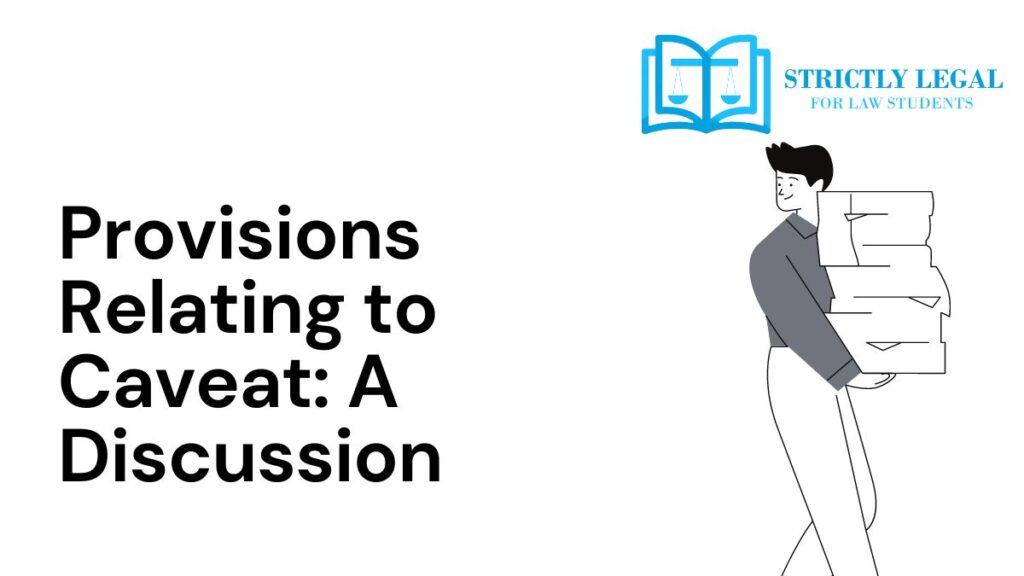Caveat is derived from a Latin term which means “let a person beware” which was formulated in the mid of 16th century. Generally, in law, it may be taken as just a notice, especially in probate, that specific actions may not be taken without having the person informed about who gave the notice. It may be very simply taken as a warning, however, in the Civil Procedure Code [herein after referred to as CPC], it was recommended u/s 148A by the recommendations of the then Law Commission of India and was finally inserted int the Code of Civil Procedure (Amendment) Act, 1976.
However, it is to be kept in mind that CPC has never clearly defined the term “Caveat” but in the case of Nirmal Chand v. Girindra Narayan, the court of law defined the term Caveat as a warning provided by an individual to the court that no notice or order would pass without serving the notice or without hearing the Caveator. A caveator is the one who files the Caveat, and the person who has instituted the suit or is likely to do the same is called Caveat. The sole purpose of a Caveat is to make sure that the court of law does not pass an ex parte order and that the interests of the Caveator stay shielded. It also deducts the burden on the courts and ends the litigation by reducing the multiplicity of the proceedings.
Table of Contents
When to lodge a Caveat?
When anyone discerns that some case has been filed against them or is about to be filed against them, in any court of law, via any manner, such a person holds a right to lodge a Caveat. The Caveat may be lodged in the form of a petition under any Court of Law in the following situations:
- During an occurring suit or litigation and in that the application has already been made or is expected to be made;
- The suit is about to be set in motion and in that suit, an application is expected to be made.
By whom a Caveat might be lodged?
A Caveat can nonetheless be lodged by any person, may it be a party to the suit or as long as the person filling a Caveat has the right to appear before the court of law on account of the suit in question, may lodge a Caveat as mentioned u/s 148 A of CPC. Nonetheless, it is to be kept in mind that a Caveat CAN NOT be filed by someone who is not related to the case by any means or who can be called a total stranger to the case. It was decided in the case of Kattil Vayalil Parkkum Koiloth v. Mannil Paddikayil Kadeesa Umma.
The Caveat may be filed by the aforementioned persons at any Civil Court of original jurisdiction, appellate court, High Court as well as Apex Court. Nonetheless, it was finalized that Section 148A of CPC applies to civil proceedings only and a caveat cannot be made against criminal proceedings, as given a verdict in the case of Deepak Khosla v. Union of India and Ors.
Information a Caveat MUST contain
To file a successful caveat or a notice provided to the Court of Law that certain specific actions may not be taken without the knowledge or information the Caveator must contain the following information:
- Name of the Caveator,
- Address of the Caveator where the notice would be sent,
- The name of the Court where such caveat is filed,
- The number of suits and number of appeals likely to be filed,
- Name of the possible plaintiffs or appellants or respondents.
Common faults that occur while filing a Caveat
Some of the common and well known faults that occur while filing a caveat are as follows:
- The Caveat is generally and often filed in support of an application, it is noteworthy to keep in mind that a caveat can be only made against an application.
- The caveator often forgets to serve a notice to the applicant, which is compulsory u/s 148A of the Code of Civil Procedure.
- Caveators often allege that orders from the Honorable Court of Law or their precedents/ judgement are incorrect because the notice was served, even after the commencement/ termination period. It is a primary thing to keep in mind that after ninety (90) days a fresh and new caveat needs to be filed.
Law student.
Believes in penning down thoughts!

